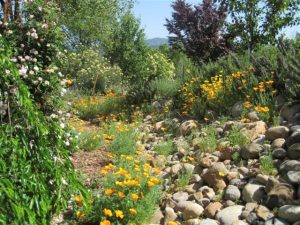As the California drought enters its sixth year, our yards, gardens and forests are struggling to stay alive. I needed help in picking plants for my garden that were sustainable during the dry weather periods in California. I discovered a list of 100 Arboretum “All-Stars” that makes it easy to select plants that are “green” choices for your garden. The horticultural staff of the UC Davis Arboretum have identified 100 tough, reliable plants that have been tested in the Arboretum, are easy to grow, don’t need a lot of water, have few problems with pests or diseases and perform beautifully in the garden. Many of these plants are California natives that attract birds and insects – all beneficial pollinators.
The goal of the program is to encourage gardeners to replace water-loving plants with California natives and other drought-tolerant plants. Most “All-Star” plants can be successfully planted and grown throughout California. Plants selected as “All-stars” are attractive most of the year and thrive in Central Valley conditions. The “All-Stars were tested by Master Gardeners in eight California climate zones and found to be suitable for terrain below 4,000 feet.
In order for a plant to qualify for the “All-Star” list, it must be low maintenance, drought tolerant and attract beneficial wildlife, including pollinating insects. Most of the plants listed on this site require watering only once every one or two weeks. Some plants only need to be watered once a month. Here are some suggestions:
PERENNIALS, which can include ferns, bulbs and other flowering plants, I suggest Nepeta faassenti-hybrid catmint. Also try Achillea mille folium “Island pink” yarrow.
GROUNDCOVERS are low growing, and fill in bare areas in the garden with color. Teucrium chamaedrys Nanum – dwarf germander is a good choice.
VINES that climb fences to create a living screen give a different look to your garden. Many vines also grow on the ground. I suggest one that blooms in the winter: Aristolochia California, or California pipevine. It is a native plant. The leaves provide food for the pipevine swallowtail butterfly larva. This vine will grow on the ground as well as becoming a climbing vine.
SHRUBS are woody plants that grow less than 15 feet tall. They have a deeper root system, and many boast showy flowers. They form the foundation and structure of a drought – tolerant garden. I chose Acacia boarmanii – Snowy river wattle. This shrub also blooms in winter.
TREES grow more than 15 feet tall. Their water needs range from once a month to weekly during the dry season. Acca sellowiana – pineapple guava – is a small tree that can be used for hedging and attracts humming birds
The UC Davis Arboretum is a searchable plant data base that lets you pick the perfect “All Stars” for your specific garden conditions. In addition to listing the plants by your individual criteria, the site lists the plant’s pruning needs, sun exposure, water needs, blooming season and wildlife value of each plant that you select. Try it out for yourself and happy gardening! Here is the link:
http://arboretum.ucdavis.edu/plant_search.aspx
Jim Gormely is a University of California Cooperative Extension Master Gardener of Tuolumne County who lives in the Sonora area.


